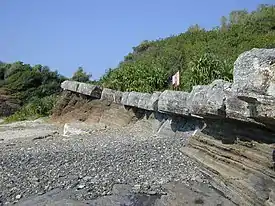Chert
Chert ( /ˈtʃɜːrt/) is a hard, fine-grained sedimentary rock composed of microcrystalline (or cryptocrystalline) crystals of quartz,[1] the mineral form of silicon dioxide (SiO2).[2] Chert is characteristically of biological origin but may also occur inorganically as a chemical precipitate or a diagenetic replacement, as in petrified wood.[3]
| Sedimentary rock | |
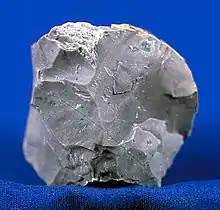 Chert |
Chert is typically composed of the petrified remains of siliceous ooze, the biogenic sediment that covers large areas of the deep ocean floor, and which contains the silicon skeletal remains of diatoms, silicoflagellates, and radiolarians.[4] Precambrian cherts are notable for the presence of fossil cyanobacteria.[5] In addition to microfossils,[4] chert occasionally contains macrofossils.[6][7] However, some chert is devoid of any fossils.[8]
Chert varies greatly in color (from white to black), but most often manifests as gray, brown, grayish brown and light green to rusty red[9][10] (occasionally dark green too);[11] its color is an expression of trace elements present in the rock, and both red and green are most often related to traces of iron (in its oxidized and reduced forms respectively).[4][12]
Occurrence

Chert occurs in carbonate rocks as oval to irregular nodules in greensand, limestone, chalk, and dolomite formations as a replacement mineral, where it is formed as a result of some type of diagenesis. Where it occurs in chalk or marl, it is usually called flint. It also occurs in thin beds, when it is a primary deposit (such as with many jaspers and radiolarites). Thick beds of chert occur in deep marine deposits. These thickly bedded cherts include the novaculite of the Ouachita Mountains of Arkansas, Oklahoma, and similar occurrences in Texas and South Carolina[13] in the United States. The banded iron formations of Precambrian age are composed of alternating layers of chert and iron oxides.
Chert also occurs in diatomaceous deposits and is known as diatomaceous chert. Diatomaceous chert consists of beds and lenses of diatomite which were converted during diagenesis into dense, hard chert. Beds of marine diatomaceous chert comprising strata several hundred meters thick have been reported from sedimentary sequences such as the Miocene Monterey Formation of California and occur in rocks as old as the Cretaceous.[14]
Terminology
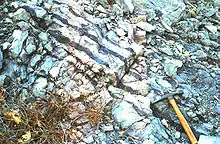
In petrology the term "chert" is used to refer generally to all rocks composed primarily of microcrystalline, cryptocrystalline and microfibrous quartz. The term does not include quartzite. Chalcedony is a microfibrous (microcrystalline with a fibrous structure) variety of quartz.[15]
The term "flint" is often reserved for varieties of chert which occur in chalk and marly limestone formations.[16][17] Among non-geologists, the distinction between "flint" and "chert" is often one of quality – chert being lower quality than flint. This usage of the terminology is particularly prevalent in Great Britain where most true flint (that found in chalk formations) was indeed of better quality than "common chert" (from limestone formations).[18]
Among petrologists e.g. Philip King, Robert B. Neuman, Jarvis B. Hadley,[19] chalcedony is sometimes considered separately from chert due to its fibrous structure.
Fossils
The cryptocrystalline nature of chert, combined with its above average ability to resist weathering, recrystallization and metamorphism has made it an ideal rock for preservation of early life forms.[20]
For example:
- The 3.2 Ga chert of the Fig Tree Formation in the Barberton Mountains between Swaziland and South Africa preserved non-colonial unicellular bacteria-like fossils.[21]
- The Gunflint Chert of western Ontario (1.9 to 2.3 Ga) preserves not only bacteria and cyanobacteria but also organisms believed to be ammonia-consuming and some that resemble green algae and fungus-like organisms.[22]
- The Apex Chert (3.4 Ga) of the Pilbara craton, Australia preserved eleven taxa of prokaryotes.[23] These findings are now disputed.[24][25]
- The Bitter Springs Formation of the Amadeus Basin, Central Australia, preserves 850 Ma cyanobacteria and algae.[26]
- The Rhynie chert (410 Ma) of Scotland has remains of a Devonian land flora and fauna with preservation so perfect that it allows cellular studies of the fossils.
Prehistoric and historic uses
Tools
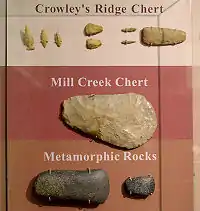
In prehistoric times, chert was often used as a raw material for the construction of stone tools. Like obsidian, as well as some rhyolites, felsites, quartzites, and other tool stones used in lithic reduction, chert fractures in a Hertzian cone when struck with sufficient force. This results in conchoidal fractures, a characteristic of all minerals with no cleavage planes. In this kind of fracture, a cone of force propagates through the material from the point of impact, eventually removing a full or partial cone; this result is familiar to anyone who has seen what happens to a plate-glass window when struck by a small object, such as an air gun projectile. The partial Hertzian cones produced during lithic reduction are called flakes, and exhibit features characteristic of this sort of breakage, including striking platforms, bulbs of force, and occasionally eraillures, which are small secondary flakes detached from the flake's bulb of force.
When a chert stone is struck against an iron-bearing surface, sparks result. This makes chert an excellent tool for starting fires, and both flint and common chert were used in various types of fire-starting tools, such as tinderboxes, throughout history. A primary historic use of common chert and flint was for flintlock firearms, in which the chert striking a metal plate produces a spark that ignites a small reservoir containing black powder, discharging the firearm.[2]
Construction
Cherts are subject to problems when used as concrete aggregates. Deeply weathered chert develops surface pop-outs when used in concrete that undergoes freezing and thawing because of the high porosity of weathered chert. The other concern is that certain cherts undergo an alkali-silica reaction with high-alkali cements. This reaction leads to cracking and expansion of concrete and ultimately to failure of the material.[27]
In some areas, chert is ubiquitous as stream gravel and fieldstone and is currently used as construction material and road surfacing. Part of chert's popularity in road surfacing or driveway construction is that rain tends to firm and compact chert while other fill often gets muddy when wet.
Varieties
There are numerous varieties of chert, classified based on their visible, microscopic and physical characteristics.[9][10] Some of the more common varieties are:
- Flint is a compact microcrystalline quartz. It was originally the name for chert found in chalk or marly limestone formations formed by a replacement of calcium carbonate with silica. Commonly found as nodules, this variety was often used in past times to make bladed tools. Today, some geologists refer to any dark gray to black chert as flint.[28]
- "Common chert" is a variety of chert which forms in limestone formations by replacement of calcium carbonate with silica. This is the most abundantly found variety of chert. It is generally considered to be less attractive for producing gem stones and bladed tools than flint.
- Jasper is a variety of chert formed as primary deposits, found in or in connection with magmatic formations which owes its red color to iron(III) inclusions. Jasper frequently also occurs in black, yellow or even green (depending on the type of iron it contains). Jasper is usually opaque to near opaque.
- Radiolarite is a variety of chert formed as primary deposits and containing radiolarian microfossils.
- Chalcedony is a microfibrous quartz.
- Agate is distinctly banded chalcedony with successive layers differing in color or value.
- Onyx is a banded agate with layers in parallel lines, often black and white.
- Opal is a hydrated silicon dioxide. It is often of a Neogenic origin. In fact it is not a mineral (it is a mineraloid) and it is generally not considered a variety of chert, although some varieties of opal (opal-C and opal-CT) are microcrystalline and contain much less water (sometime none). Often people without petrological training confuse opal with chert due to similar visible and physical characteristics.
- Magadi-type chert is a variety that forms from a sodium silicate precursor in highly alkaline lakes such as Lake Magadi in Kenya.
- Porcelanite is a term used for fine-grained siliceous rocks with a texture and a fracture resembling those of unglazed porcelain.
- Tripolitic chert (or tripoli) is a light-colored porous friable siliceous (largely chalcedonic) sedimentary rock, which results from the weathering (decalcification) of chert or siliceous limestone.
- Siliceous sinter is porous, low-density, light-colored siliceous rock deposited by waters of hot springs and geysers.
- Mozarkite a varicolored, easily polished Ordovician chert that takes a high polish. It is the state rock of Missouri.
Other lesser used terms for chert (most of them archaic) include firestone, silex, silica stone, chat, and flintstone.
See also
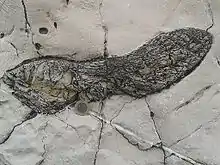
- Petrology – The branch of geology that studies the origin, composition, distribution and structure of rocks
- Eolith – A chipped flint nodule
- Nodule (geology) – Small mass of a mineral with a contrasting composition to the enclosing sediment or rock not to be confused with Concretion
- Obsidian – Naturally occurring volcanic glass
- Opal – A hydrated amorphous form of silica
- Whinstone – Quarrying term for any hard dark-coloured rock
- Archaeology – The study of the past through material culture
- Clovis Points, archaeological artefacts of the Clovis culture in New Mexico
- Piatra Tomii, a prehistoric chert mine in Alba County, Romania
References
- Knauth, L. Paul. "A model for the origin of chert in limestone." Geology 7, no. 6 (1979): 274-277.
- "Chert: Sedimentary Rock - Pictures, Definition, Formation". geology.com. Retrieved 12 May 2018.
- Bates, R. L.; Jackson, J., eds. (1984). Dictionary of Geological Terms, 3rd Ed. American Geological Institute. Doubleday. p. 85. ISBN 0385181019. OCLC 465393210.
- Boggs, Sam (2006). Principles of sedimentology and stratigraphy (4th ed.). Upper Saddle River, N.J.: Pearson Prentice Hall. pp. 208–210. ISBN 0131547283.
- Golubic, Stjepko; Seong-Joo, Lee (October 1999). "Early cyanobacterial fossil record: preservation, palaeoenvironments and identification". European Journal of Phycology. 34 (4): 339–348. doi:10.1080/09670269910001736402.
- Bonde, Suresh D.; Kumaran, K.P.N. (February 2002). "The oldest macrofossil record of the mangrove fern Acrostichum L. from the Late Cretaceous Deccan Intertrappean beds of India". Cretaceous Research. 23 (1): 149–152. doi:10.1006/cres.2001.0307.
- Kotyk, M. E.; Basinger, J. F.; Gensel, P. G.; de Freitas, T. A. (1 June 2002). "Morphologically complex plant macrofossils from the Late Silurian of Arctic Canada". American Journal of Botany. 89 (6): 1004–1013. doi:10.3732/ajb.89.6.1004.
- Boggs 206, p.207
- W.L. Roberts, T.J. Campbell, G.R. Rapp Jr., "Encyclopedia of Mineralogy, Second Edition", 1990. ISBN 0-442-27681-8
- R.S. Mitchell, "Dictionary of Rocks", 1985. ISBN 0-442-26328-7
- McBride, E.F.; Folk, R.L. (1977). "The Caballos Novaculite Revisited: Part II: Chert and Shale Members and Synthesis". SEPM Journal of Sedimentary Research. 47. doi:10.1306/212F731A-2B24-11D7-8648000102C1865D.
- Thurston, Diana R. (1972). "Studies on bedded cherts". Contributions to Mineralogy and Petrology. 36 (4): 329–334. doi:10.1007/BF00444339. S2CID 128745664.
- "OpenLearn Live: 19th February 2016: A Week In South Carolina". OpenLearn. The Open University. Retrieved 20 February 2016.
- Boggs 2006, p.206
- Boggs 2006, pp.206-207
- George R. Rapp, "Archaeomineralogy", 2002. ISBN 3-540-42579-9
- Barbara E. Luedtke, "The Identification of Sources of Chert Artifacts", American Antiquity, Vol. 44, No.4 (Oct., 1979), 744–57.
- Luedtke, Barbara E. (1992). An archaeologist's guide to chert and flint. Los Angeles: Institute of Archaeology, University of California. ISBN 0-917956-75-3. Retrieved 8 October 2020.
- Geological Survey (U.S.) (1968). U.S. Geological Survey Professional Paper. U.S. Geological Survey Professional Paper. U.S. Government Printing Office. p. 1-PA84. Retrieved 23 July 2019.
- The Earliest Life: Annotated listing Archived 2006-04-26 at the Wayback Machine
- Fig Tree Formation of South Africa
- Gunflint chert Archived 2005-06-12 at the Wayback Machine
- Biogenicity of Microfossils in the Apex Chert
- [https://carnegiescience.edu/news/portion-ancient-australian-chert-microstructures-definitively-pseudo-fossils Portion Of Ancient Australian Chert Microstructures Definitively Pseudo-Fossils
- 3.46 Ga Apex chert ‘microfossils’ reinterpreted as mineral artefacts produced during phyllosilicate exfoliation
- Cyanobacertial fossils of the Bitter Springs Chert, UMCP Berkeley
- Terry R. West. "Geology Applied to Engineering," Waveland Press, 1995 ISBN 1577666550
- Bates,, R. L., and Jackson, J. (eds.) (1984). Dictionary of Geological Terms, 3rd Ed. American Geological Institute. Doubleday. p. 187. ISBN 0385181019 OCLC 465393210
External links
| Wikimedia Commons has media related to Chert. |
- Photo & note re: Fig Tree Formation
- Microphotographs of Fig Tree fossils
- Schopf, J.W. (1999) Cradle of Life: The Discovery of Earth's Earliest Fossils, Princeton University Press, 336 p. ISBN 0-691-00230-4
- An Archaeological Guide To Chert Types Of East-Central Illinois
